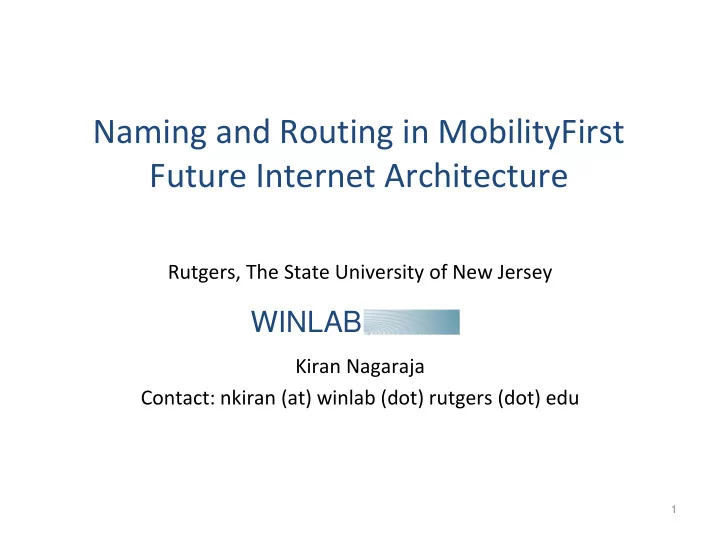

Naming and Routing in MobilityFirst Future Internet Architecture Rutgers, The State University of New Jersey WINLAB Kiran Nagaraja Contact: nkiran (at) winlab (dot) rutgers (dot) edu 1
MobilityFirst: Layered Names and Rich Delivery Services Current Internet supports only 1 level of name resolution (DNS) ‐ Hostname IP address Relegates other objects (service, content, context) to indirect naming Moreover, no support for fine ‐ grain mobility Thin in network delivery services End hosts do the heavy ‐ lifting for intermittent problems en ‐ route Pre ‐ eminence of overlay services MobilityFirst Proposal Layered naming, and direct address for hosts, services, content, context… Inherent support for mobility Rich in ‐ network services: multicast, multipath, multihoming, anycast WINLAB 2
Layered Naming SID GUID NA Payload User ‐ level descriptors E.g., Joe’s car Name Certification and Resolution Service Resolution Path E.g., Toyota Motor Corp . Network ‐ level identifier GUID: public key GUID Resolution Service Resolution Path (Network ‐ level multi ‐ entity cooperative) Routable Topological Address (Network assigned) WINLAB 3
GUID Naming for Groups and Abstract Entities GUID (YTCC) Aggregate objects under single GUID Reference or Indirection GUID: GUID GUID ‐ set Example: All cabs of Yellow Taxi Cab company Advantages: efficient group delivery, policy aggregation Challenges: Efficient topological aggregation GUID for Services or Context Taxi Service Listings Resolver Services ‘manage’ mappings : user level network ‐ level (GUID) GUID mapped to end points Taxi Dispatch “Connect me to a taxi service in New Brunswick” (Endpoint = a Taxi Dispatcher Service ) “Hail a taxi cab within 5 miles of here“ (Endpoint = ) WINLAB 4
Dynamic Resolution of GUID to Network Address: Global Name Resolution Service (GNRS) SID GUID NA Payload Secure and policy ‐ driven access Requirements: Low latency (< 100ms) to support mobile CBR apps GNRS operations: INSERT, UPDATE, LOOKUP GNRS Distribution Layer: Load Distribution, Replication Locality Layer: Caching INSERT Security Layer: Authentication, Access Control, Encryption Name Certification UPDATE LOOKUP Service LOOKUP E.g., Toyota Motor Corp . End hosts Network WINLAB 5
Progressive GUID ‐ to ‐ Address Resolution: Global/Local Resolution Services SID GUID NA Payload Addresses resolved incrementally to progress the packet towards destination network Limits granularity of location at GNRS with finer details at local resolvers Direct binding is optional, but is less desirable for mobile scenarios Late binding or re ‐ resolution upon failures GNRS Destination Network: Local NRS Local NRS Progressive/Late binding Local NRS Local NRS Local NRS Local NRS At Source: Early binding In ‐ Network: Progressing binding WINLAB 6
Routing: Flat Names, Edge ‐ Aware, Service ‐ Rich Network Topology Minimally hierarchical, flat names for networks Aggregate topological constructs to expose finer topology within a network Dynamic attachments of ad hoc and transient networks Network Network Aggregation (N2) (N1) Nodes: Represent aggregate information of sub-graph Subnet N2.1 Subnet N2.2 Ad hoc Net (AN3) Dynamic attachment of ad hoc networks to global network. Reachability may be announced through GNRS WINLAB 7
Edge ‐ Aware Inter ‐ Domain Routing SID GUID NA Payload Approach under consideration is to enhance BGP ‐ like protocols with summary node/link info (aggregate node) Summary knowledge of access net properties (Mbps, % avail, etc.), ingress/egress points and alternate paths exchanged between networks/ASs Network topology information for identifying multiple paths, storage points … Inspired by “Vnode” concept in “Pathlet” routing (Godfrey, 2008) Support for multicast, anycast, multihoming and multipath Example of dual ‐ homing route Edge Network Supported by routing protocol Transit Network V74 V21 V71 V22 Aggregated Vnode properties & path info V23 V11 V72 V12 V73 V13 WINLAB 8
Storage ‐ Aware, Disruption ‐ Tolerant Local Routing Storage aware (CNF, generalized DTN) routing exploits in ‐ network storage to deal with varying link quality and disconnection Routing algorithm adapts seamlessly from switching (good path) to store ‐ and ‐ forward (poor link BW/short disconnection) to DTN (longer disconnections) Temporary Storage at Router Initial Routing Path Low BW cellular link Re ‐ routed path For delivery Mobile Device PDU trajectory Storage Router High BW Sample CNF routing result WiFi link WINLAB 9
Extensible, End ‐ User Requested Delivery Services SID GUID NA Payload anycast multicast multihoming DTN realtime content-caching… . compute Compute plane services for in ‐ network packet processing ISP infrastructure services: DDoS prevention, content caching Cloud ‐ computing for end ‐ user services Architecture allows for new services to be incrementally added WINLAB 10
Summary of Naming and Routing in MobilityFirst Architecture embraces layered and direct naming for clean separation of identity and location Mobility Groups and contexts named similarly as individual objects Support for references and indirection Edge ‐ aware routing to support efficient and flexible delivery options for mobile and multi ‐ homed end points Extensible, service ‐ oriented network WINLAB 11
Recommend
More recommend